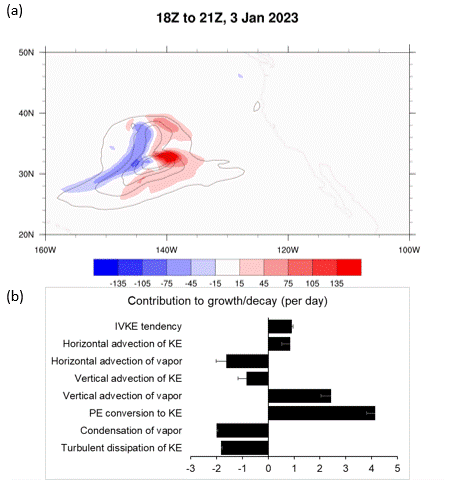Research about Atmospheric Rivers

The evolution of an atmospheric river event from 18 to 21 UTC, 3 January 2023 to 18 to 21 UTC, 4 January 2023 from 3-hourly MERRA-2 data. The upper panel shows integrated vapor kinetic energy (IVKE) (contours, minimum level: 15 kg/s^2, interval: 30 kg/s^2) and IVKE tendency (shading, units: kg/s^2/(3 hr)) in each 3-hour period. The lower panel shows IVKE budget analysis using data from each 3-hour period.
Atmospheric rivers (ARs) are long, narrow bands of intense water vapor transport, typically spanning over 1000 km in length and more than 100 km in width, moving primarily eastward. ARs play an essential role in the poleward transport of water vapor in mid-latitudes and can bring extreme wind gusts, intense precipitation, and flooding to densely populated regions along the coast.
Motivation
ARs involve both vapor and winds. Most AR tracking methods consider these two components together. However, previous studies explaining AR dynamics often treated the evolution of vapor and winds separately. This separation was primarily due to the lack of a quantitative framework that accounts for both factors cohesively.
Modeling approaches
My research introduces a new framework for understanding AR dynamics based on a prognostic equation for integrated vapor kinetic energy (IVKE). Incorporating physical processes governing both vapor and wind evolution, this framework allows us to quantify their respective contributions to AR evolution and thereby provides a more comprehensive understanding of AR behavior.
Main findings
The growth of ARs is primarily driven by potential energy conversion to kinetic energy, while their decay results from vapor condensation and turbulent dissipation. The eastward drift of ARs is primarily due to horizontal advection.
Broader Impact and Prospects
The IVKE framework offers a quantitative analysis framework for addressing key questions related to AR-induced hydrologic extremes. This research has the potential to enhance our ability to prepare for and respond to the impacts of ARs.
Project Status
My ongoing main project (2021-)
